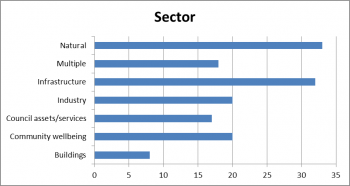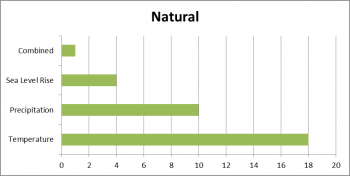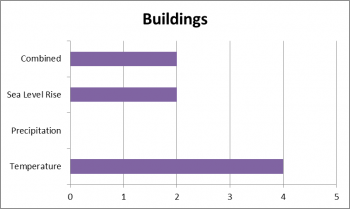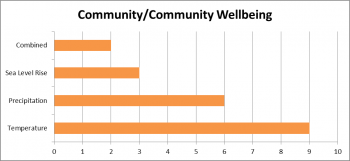The regional results from the initial risk identification process assist in understanding and managing regional climate risks and inform opportunities for priorities for adaptation across the Region.

Figure 21: Risks by sector
The next section details the results of the risk assessment, grouped by theme. The six themes are:
- Natural assets
- Buildings
- Community wellbeing
- Industry
- Council assets and services
- Infrastructure
The results in Figure 21 indicate that natural assets and infrastructure are considered to be the most impacted sectors followed by industry (mainly agricultural), community and council (assets and services). It should also be noted that it is likely that the risks in the infrastructure, community wellbeing, buildings and the multiple sector categories are most likely to equally apply to council assets and services. If these were all added together then it would indicate that approximately 66 per cent of risk relates to council assets and services.

Figure 22: Natural asset risk by climate variable
The projected changes in temperature are the main cause of the risks identified for most sectors in the Region and this is particularly so for natural assets and industry. Sea level rise is also a key risk for the infrastructure sector. After temperature, all climate variables are equally impacting council assets and services.
The full set of risk statements that relate to natural assets are in Table 18 in Appendix 4.

Figure 23: Building sector risk by climate variable
The climate risks associated with buildings developed by the participating councils are included in Table 19 in Appendix 4.

Figure 24: Community sector risk by climate variable
Council will have a major challenge managing the impacts from extreme heat and other associated impacts to highly sensitive residents such as the elderly, children and infants due to their limited adaptive capacity to deal with the projected significant increases in extreme heat events over 40 o C. During a heat wave these residents typically have less access to air conditioning, due to high power running costs; have greater difficulty understanding emergency response directions and health warnings; and potentially suffer greater health effects due to their age and physical condition. This can lead in turn to increased demand on these services. These vulnerabilities in the community will require detailed investigation and analysis.
The climate risks associated with community wellbeing developed by the participating councils are included in Table 20 in Appendix 4.
Participants highlighted a number of key climate risks to local industries in the Region. These were mainly centred on agricultural practices that could be particularly vulnerable to the projected changes in temperature and precipitation.
Table 21 in Appendix 4 lists these climate risks.
All councils are exposed to the risks associated with an increase in temperature - both extreme heat events, increase in mean temperature and associated decreases in mean precipitation. The risks associated with these future climate conditions can combine and lead to water security issues in the Region as well as heat stress amongst the community.
All councils are directly exposed to the risks associated with sea level rise such as key council assets are at risk from inundation. Councils also cited exposure to the risks associated with increased storm surge and storm activity in these coastal areas, as well as an associated increase in sea spray and salinity impacts.
All councils included risks relating to increased heat, drought conditions and less rainfall leading to an increase in bushfire risk conditions.
Although not a focus of the current analysis councils also cited that the Region would most likely be exposed to the risks associated with increased storm activity.
This was not a focus of this analysis and risk assessment. There are a number of other climate effects that affect the Region but were not the focus of this assessment.
The full set of risk statements related to council assets and services are in Table 22 in Appendix 4.
The councils developed a large number of risk statements related to infrastructure assets, which are provided in Table 23 in Appendix 4. Many of these assets are coastal infrastructure such as roads, bridges, piers, walkways and lookouts etc, located in areas adjacent to the shoreline or tidal rivers on the coast.
The risks to council assets include:
- Increased heat events leading to higher rates of deterioration of buildings and built assets resulting in higher maintenance costs for roofing, cladding, window and other systems.
- Increase severity of precipitation events causing localised flooding, resulting in the inundation of infrastructure and increased maintenance and repair costs, disruption to services and damage/blocking of drainage sewerage systems and contamination of waterways
- A decrease in mean precipitation leading to a reduction in environmental flows and impacts on infrastructure integrity and performance (drainage pipes crack in low flows) causing increased maintenance and upgrade costs. Councils also cited the increased risk of landslides and increased costs to upgrade and maintain infrastructure. This also results in reduced water security and reliability
- Sea level rise and storm surge resulting in the erosion of coastal assets (including marinas and boat ramps) and higher maintenance/replacement costs, loss and damage, flooding of roads affecting access and egress issues and the reduction in transport routes across the Region (especially along the Great Ocean Road). They also mentioned threats to inundation of coastal landfill (disused) and septic tanks, resulting in pollution. Heritage items on the coast (e.g. The Breakwater- Warrnambool) were also listed.
Most concerning climate variables
Other infrastructure at risk








